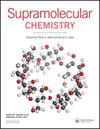(Self) assembled news: recent highlights from the supramolecular chemistry literature (Quarter 2, 2023)
IF 2.6
4区 化学
Q3 CHEMISTRY, MULTIDISCIPLINARY
引用次数: 0
Abstract
Allostery – the control of macromolecule conformation and function by the remote binding to an effector molecule – allows numerous biological machines to carry out their roles in the body. Writing in Chem, Cheng-Yong Su and colleagues have described a metallo-amine cage (MOC-68, Figure 1) that exhibits intricate, proton-driven allostery underpinned by water binding and release [1], with implications in controlled guest binding, transport and release. MOC-68 (Figure 1) comprises flexible, amine corners and face-capping metalloligands containing imidazole linkers; thus, numerous acid/base sites are accessible. When protonated, these sites bind water molecules which rigidify the cage; when deprotonated, water is released and the conformational flexibility of the cage increases. The initial state can only bind guests on the exterior of the cage (exo-binding); however, pH-driven allosteric switching provides a larger cavity, allowing endobinding. Interestingly, the corners of the cage can be capped with CB[10], yielding a rare ‘ring-on-cage’ system. This locks the conformation of the cage, can trigger the release of endo-bound guests, and prevents allosteric switching and endo-guest binding. Another consequence of the changes in protonation state is that the charge of the cage can be drastically altered by changing the pH. This affects the polarity of the system and means that the cage can reversibly phase transfer from polar to non-polar solvent mixtures.(自我)汇编新闻:超分子化学文献的最新亮点(2023年第2季度)
变构-通过远程结合效应分子来控制大分子的构象和功能-允许许多生物机器在体内发挥它们的作用。在Chem上,Cheng-Yong Su及其同事描述了一种金属胺笼(MOC-68,图1),它表现出复杂的质子驱动变构,以水的结合和释放为基础[1],这意味着受控的客体结合、运输和释放。MOC-68(图1)包括柔性、胺角和含有咪唑连接剂的面盖金属配体;因此,可以访问许多酸/碱位点。当质子化时,这些位点与水分子结合,使笼变硬;当去质子化时,水被释放,笼的构象柔韧性增加。初始状态下只能将来宾绑定在笼的外部(外绑定);然而,ph驱动的变构开关提供了更大的空腔,允许内结合。有趣的是,笼子的角落可以用CB[10]封顶,从而产生罕见的“笼上环”系统。这锁定了笼的构象,可以触发释放内结合客体,并防止变构转换和内结合客体。质子化状态变化的另一个结果是,笼的电荷可以通过改变ph值而急剧改变。这影响了系统的极性,意味着笼可以从极性溶剂混合物可逆地相转移到非极性溶剂混合物。
本文章由计算机程序翻译,如有差异,请以英文原文为准。
求助全文
约1分钟内获得全文
求助全文
来源期刊

Supramolecular Chemistry
化学-化学综合
CiteScore
3.60
自引率
3.00%
发文量
5
审稿时长
2.7 months
期刊介绍:
Supramolecular Chemistry welcomes manuscripts from the fields and sub-disciplines related to supramolecular chemistry and non-covalent interactions. From host-guest chemistry, self-assembly and systems chemistry, through materials chemistry and biochemical systems, we interpret supramolecular chemistry in the broadest possible sense. Interdisciplinary manuscripts are particularly encouraged. Manuscript types include: high priority communications; full papers; reviews, and; Methods papers, techniques tutorials highlighting procedures and technologies that are important to the field. We aim to publish papers in a timely fashion and as soon as a paper has been accepted and typeset it will be published in electronic form on the Latest articles section of the website. The two most important review criteria are that the paper presents high-quality work that fits generally into the broad spectrum of activities in the supramolecular chemistry field. Under normal circumstances, Supramolecular Chemistry does not consider manuscripts that would be more suitable in a highly specialized journal. This includes, but is not limited to, those based mostly or exclusively on topics such as solid state/X-ray structures, computational chemistry, or electrochemistry. .
The two most important review criteria are that the paper presents high-quality work that fits generally into the broad spectrum of activities in the supramolecular chemistry field.
 求助内容:
求助内容: 应助结果提醒方式:
应助结果提醒方式:


